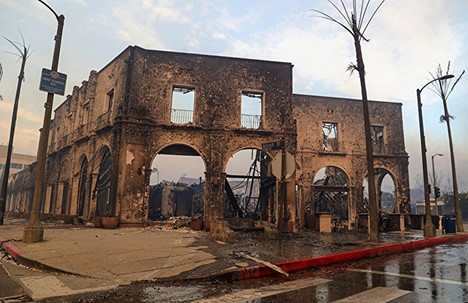We lived in the Pacific Palisades for twenty years. It was an idyllic place and community to raise three children. When we first arrived, it was a sleepy little seaside village, a welcomed respite from the hustle and bustle of Los Angeles.
And now it’s completely gone.

All that remains from this once vibrant and charming village of the Pacific Palisades, CA
It’s so unimaginable, so surreal, to think such a beautiful place that harbored our homes, schools, shops, markets, offices, churches, library, parks, trees, and wildlife, now lie in ashen ruins and erased from the earth. Yes, they will rebuild in time, but the identity of the Palisades as we knew it is gone forever.
This horrific event and my recent near death health scare have made me ponder the dynamic of impermanence. For Buddhists, the reality of continuous change is one of the characteristics of our human existence and is often translated from the Pali term anicca as “impermanence”. They teach nothing in the universe is essential – that everything that comes also goes, everything that lives must also die, and everything that is created will crumble.
For someone who’s had control issues his entire life, and in dire need for answers to the unanswerable, I’ve always found the concept of impermanence to be a wee bit daunting. Like my grandmother used to say, “I welcome change as long as nothing is altered or different than before.” That’s not to say I don’t love and embrace adventure and the uncertainty of the future. After all, Lincoln said it best, “The best way to predict the future is to create it.” I’ve always found that to be a guiding principle for achieving a modicum of self-perceived control. That is until some unforeseen event occurs that alters everything we were intractably attached.
Such is the case with the fires in Los Angeles and the destruction of thousands of homes that held cherished memories and stories that happened among those walls. Homes that were the bedrock and safety in an uncertain world. Homes and a community that provided a reassuring security of identity, place, and comfort. And despite our hopeful desire to believe comfort was in itself a respite from life’s uncertainty, it unfortunately can’t prevent the impermanence of life.
I remember a time when I was in the Stella Adler’s acting workshop, and during a break I was relaxing with my feet propped up on a seat in front of me. I felt a tap on my shoulder and I looked up to see Stella imperiously standing above me while quietly instructing with a knowing twinkle, “Put your feet down – it’s not good for an artist to be comfortable.”
My heart goes out to all those who have lost all their material possessions and community. It’s beyond tragic. However, the struggles they are now facing will in turn present new opportunities and perspectives as they carry on and continue to create new chapters that will resonate with the appreciation for being able to celebrate the miracle of being alive.
So, I guess impermanence is both good and bad news. The bad news is that nothing we enjoy stays the same. It changes and ends. The good news is that the suffering caused by our clinging to conditioned things can also be transformed into greater understanding and gratitude. I’ve been a firm believer that the key to accepting the impermanence of life is the appreciation of the present moment in all its fullness. My dog, Roscoe, reminds me of this daily.
So, here’s to each of us accepting the impermanence of life, where each moment is appreciated for its fleeting nature, and that every new day could be our last. I wish for you all to live life to the fullest extent possible – to create, to love, to being loved.
Slainte!







